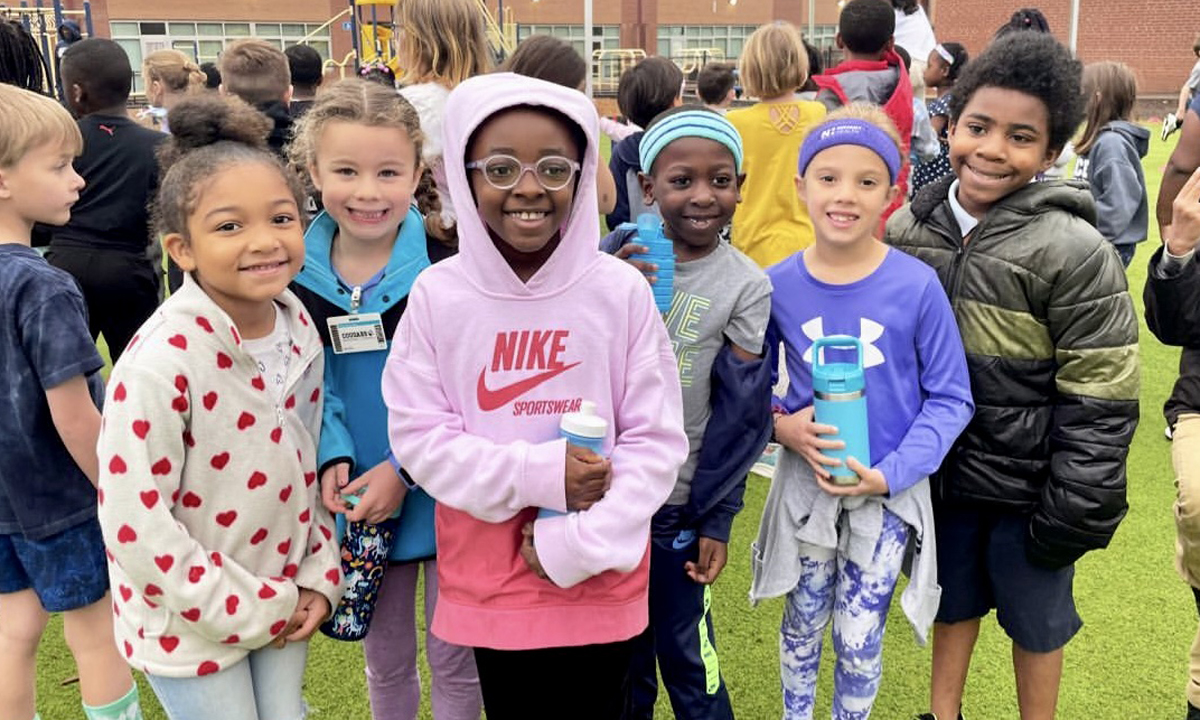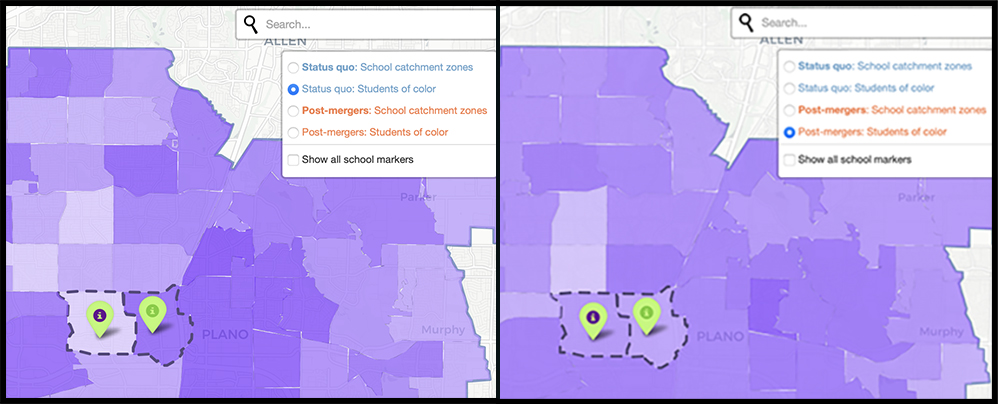New Research: School ‘Pairings’ Can Foster Racial, Socioeconomic Integration
At a time when the nation’s leaders question the value of diversity, one principal says her school 'looks like the world.'

Get stories like this delivered straight to your inbox. Sign up for The 74 Newsletter
Alicia Hash spent her first seven years as a principal leading Cotswold Elementary in Charlotte, North Carolina. The majority white school boasted an award-winning International Baccalaureate program and was the reason many parents with young children bought homes in the neighborhood.
Roughly a mile away, the demographics at Billingsville, another K-5, sat in stark contrast. Located in the Grier Heights neighborhood — an old farming community founded by a former slave — Billingsville was a high-poverty school serving an all-Black student population.
“We operated in silos that I never understood as a principal,” Hash said.
Portable classrooms on Cotswold’s overcrowded campus were evidence of the school’s popularity, while Billingsville occupied a brand new building with room to spare.
In 2018, the two schools became part of a unique experiment that was unlike any student assignment plan families had ever been part of. The schools would merge, but instead of moving into one building, the early grades would occupy Billingsville, and Cotswold would serve grades 3 through 5.
Almost immediately, under the new arrangement, Billingsville went from having one white student to being 40% white, Hash said. Both schools now offer the rigorous IB program and have a more racially and socioeconomically balanced population. Across both schools, less than half of the students live in poverty, 41% students are Black, about 17% are Hispanic and 34% are white.
“Our school looks like the world. Our school looks like Charlotte,” Hash said.
The student assignment method, called a pairing, is not new. In fact, the Charlotte-Mecklenburg district employed the same design in the 1970s following a U.S. Supreme Court decision that required the district to desegregate. But the model has been underutilized as an integration strategy, experts say.
Now, new research shows that such mergers could reduce racial and ethnic isolation by as much as 60% in 200 large school districts nationwide. At the same time, the method would increase parents’ commute to school by only a few minutes — not a small matter for families managing busy drop-off and pick-up schedules.
“What we’re trying to do … is highlight how student assignment policy changes might help produce environments that can reduce the concentration of different forms of disadvantage,” said Nabeel Gillani, an assistant professor at Northeastern University in Boston, and the lead researcher on the project. “Disadvantage can prevent young people and their families from reaching their potential.”

Under a 2007 Supreme Court decision, schools are no longer permitted to consider race when pursuing integration goals. But blending schools with different socioeconomic profiles can still result in more racially diverse schools. In a moment when leaders of the ruling party in Washington want to “end multiculturalism” and argue that “diversity is not our strength,” Gillani urges districts not to back off efforts to create more integrated schools. He said he hopes that the Trump administration’s warnings against any emphasis on racial diversity “will light a stronger fire under more districts” to consider pairing, “instead of scaring them away.”
Along with the research paper, released Tuesday in the Proceedings of the National Academy of Sciences’ Nexus journal, Gillani and doctoral student Madison Landry created an online tool that shows how pairing, and sometimes tripling, would change school demographics in communities across the country.
For example, in Plano, Texas, 26% of the students at Shepard Elementary are non-white, according to 2022 data, while 83% of students at Sigler, about six minutes away, are non-white.
Pairing the two schools would more than double the percentage of students of color at Shepard and decrease the percentage at Sigler to 52.9%, bringing both closer to the districtwide figure of 65%.

‘A desired racial balance’
Across the country, data shows that schools have grown increasingly divided by race, ethnicity and family income. A 2022 report from the U.S. Government Accountability Office showed that more than a third of students attended schools in 2020-21 where 75% or more students were of a single race or ethnicity. Research, however, shows that students who attend integrated schools have higher test scores and lower dropout rates.
In 2017, Billingsville earned a D rating from the state. Now the combined Billingsville-Cotswold earns a C, but also met its academic growth target, a measure that captures progress from year to year.
Such results are one reason why the Biden administration in 2023 took steps to encourage districts to implement strategies like pairing. The U.S. Department of Education awarded $14 million to states, districts and charter networks working to create more integrated schools.
Gillani has advised one of the recipients, the Winston-Salem/Forsyth County Schools in North Carolina, as it develops a redistricting plan. While the plans don’t involve pairing, leaders are still redrawing boundaries with an eye toward reducing socioeconomic isolation across the district.
Other recipients included a Rhode Island charter network, the Oakland Unified School District in California and the Maryland Department of Education.
A department spokeswoman said she had no information about whether the program would continue, but one advocate for school integration doubts it, considering the administration’s opposition to diversity efforts.
“I think it’s unlikely that they would run another competition for that grant under this administration,” said Halley Potter, a senior fellow at The Century Foundation, a left-leaning think tank.
In fact, the department’s Feb. 14 “dear colleague” letter warned districts against taking steps to “achieve a desired racial balance or to increase racial diversity.”
But “socioeconomic diversity has its own independent value,” said Richard Kahlenberg, director of housing policy at the Progressive Policy Institute, a left-leaning think tank. “There is a wealth of research to suggest that students benefit from attending a mixed-income school … even if there is zero impact on racial diversity.”
The Supreme Court has also upheld race-neutral policies. Within the past year, the court has declined to hear two cases, one from Boston and one from Fairfax County, Virginia, that challenged efforts to create more diversity in highly selective schools.
“The judiciary will almost surely uphold socioeconomic integration plans at the end of the day,” Kahlenberg said.
Even though the federal grant program was small, Potter said she hopes the efforts would offer “some important proof points” for how to encourage integration at a time when many districts are considering mergers because of declining enrollment.
“There really is a chance to have a win-win situation when it’s structured right,” she said, “and when there’s community engagement to work through these hard conversations.”
‘Why are they changing everything?’
One benefit of pairing — over a typical redistricting plan that reassigns students to new schools — is that it doesn’t split up peers from the same grade level. They might relocate to a different building, but they stay with their friends.
That doesn’t make it easy, however. Families often have multiple children in the same elementary school and arrange afterschool programs and child care around that location.
“Our first reaction was ‘Oh gosh, why are they changing everything?’ ” said Brantley Alvey, whose oldest daughter, now in seventh grade, went through the merger. Her youngest is in fifth grade at the school. “When we bought our house, we said ‘We love that our kids are going to walk to elementary school for six years.’ ”

Parents also had questions over how the makeup of their children’s classrooms would change after the merger.
“Would they be the only child of color or would they be the only child that wasn’t of color?” Hash recalled. “Those were real conversations that we had to tackle.”
To help parents manage morning and afternoon routines, the schools have staggered bell schedules. The district also spent the entire 2017-18 school year preparing families for the change. Hash organized campus beautification days and concerts to help families from the two schools get to know each other. She said she had to view the merger of communities not just from an instructional and management perspective, but with a “micro-political lens.”
“You have to lean in with how we’re alike versus how we’re different,” she said. “This is a model that can be replicated across the United States, not just in Charlotte.”
Hash is the principal for both campuses, dividing her time between the two. Because of the pairing, Alvey said, the school has benefited from more resources — like two full-time art teachers, and more playground equipment and library books. For parent leaders, however, organizing carnivals and other family events has often been “labor intensive,” she said. “We’re constantly feeling like we have to duplicate our efforts on two different campuses.”

While the positives, she said, have outweighed the negatives, the one-school, two-campus model won’t be in place much longer. New construction projects will eventually bring all K-5 students together in a newly built Cotswold, while the Billingsville site becomes a district Montessori school. Grier Heights families will be able to choose which school they want their children to attend.
Still, Alvey said the pairing has benefited her children and helped to break down barriers between the two neighborhoods — especially since both schools feed into the same middle and high school.
“It’s not just low-income kids that benefit from diversity; it’s the higher income kids as well,” she said. “We want our kids to be comfortable with people from different backgrounds and different cultures. That’s only going to better prepare them to be good citizens of the world.”
Get stories like these delivered straight to your inbox. Sign up for The 74 Newsletter

;)
